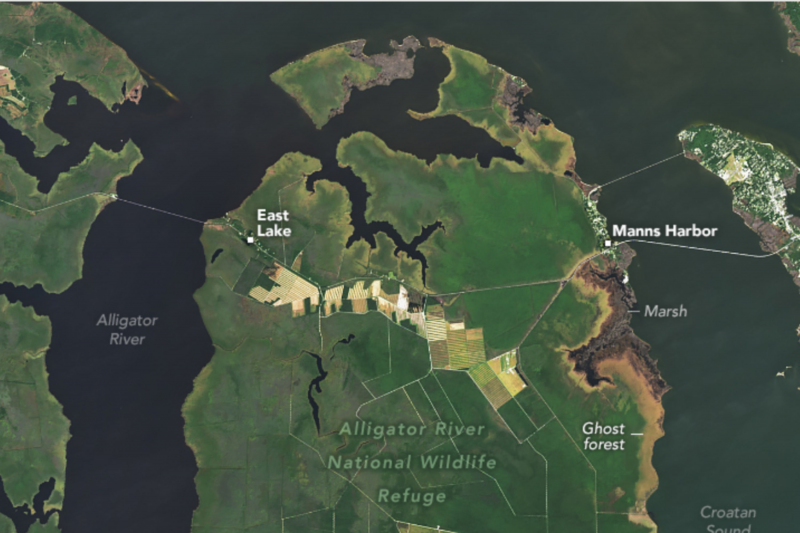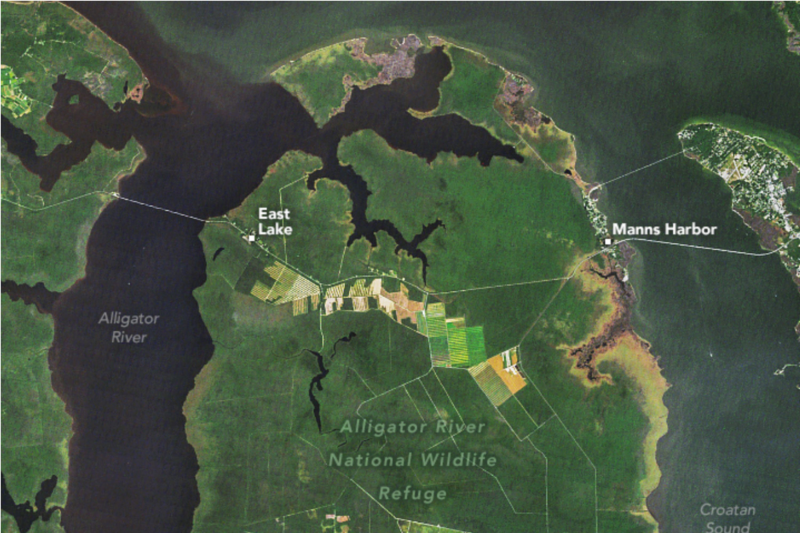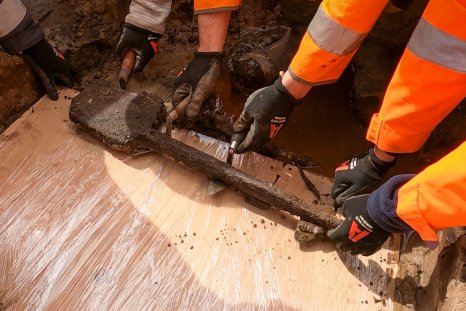Pictures of spooky "ghost forests" in North Carolina have been snapped from space, and a comparison of NASA images show how the bald cypress forests are being killed off.
In 2024, the forests along the coastline of North Carolina's Albemarle-Pamlico Peninsula have grown increasingly brown, compared to the verdant green of the same region in 2005.
Ghost forests are coastal woodlands where trees have died due to rising sea levels, leading to saltwater intrusion and erosion. The salty water of the sea contaminates the groundwater that these forests rely on, affecting the soil chemistry and tree health, slowly killing the forests near the coast, according to the National Oceanic and Atmospheric Administration (NOAA).
Eventually, the dead trees fall over and decompose, but while they're still standing, they appear eerily zombielike against the healthy surrounding landscape.
Drag slider compare photos


"The closer a forest is to sea level, the greater the risk of tree death and the detection of ghost forests," Xi Yang, an environmental scientist at the University of Virginia told NASA Earth Observatory.
These ghost forests are popping up around North Carolina and the East Coast, affecting a vast number of tree species from cypress to pines. The area affected by these dying trees is increasing rapidly, with a 2021 paper finding that 11 percent of forested land in North Carolina's largest coastal wildlife refuge became ghost forest between 1985 and 2019.
"The formation of this ghost forest transition state peaked prominently between 2011 and 2012, following Hurricane Irene and a 5-year drought, with 4,500 ± 990 hectares of ghost forest forming during that year alone," researchers wrote in the 2021 paper, published in the journal Ecological Applications.
This increase in ghost forest coverage is due to increasing sea levels worldwide, caused by spiking global temperatures and melting polar ice caps. Along the U.S. East Coast in particular, sea level rise appears to be being exacerbated by land subsidence, with North Carolina's sea level rising three times faster than the worldwide average, at between 3 mm and 4 mm per year.
"The sinking on the East Coast is driven by several factors from natural to anthropogenic processes. The major natural processes are glacial isostatic adjustment (GIA) and natural sediment compaction. The major anthropogenic factor is fluid withdrawal from the ground. These factors contribute to the sinking of the coast," Leonard Ohenhen, previously a Ph.D. student at Virginia Tech, told Newsweek.
Forests along the coast serve as natural buffers, protecting inland areas from storm surges and erosion, meaning that their loss increases the vulnerability of coastal communities. Additionally, the increase in ghost forests in the bald cypress forests of North Carolina is killing off some of the oldest living trees in the eastern U.S.
"You can also see the effects of climate change collide with human development in Landsat images like this," Duke University ecologist Emily Bernhardt told NASA Earth Observatory.
"Marshes shift locations over time as sea levels rise, but there's nowhere for cypress forests to go. They're already hemmed in by farmland or other development, so these iconic wetlands are getting squeezed and dying off in mass mortality events instead."
References
Ury, E. A., Yang, X., Wright, J. P., & Bernhardt, E. S. (2021). Rapid deforestation of a coastal landscape driven by sea‐level rise and extreme events. Ecological Applications, 31(5). https://doi.org/10.1002/eap.2339
Disclaimer: The copyright of this article belongs to the original author. Reposting this article is solely for the purpose of information dissemination and does not constitute any investment advice. If there is any infringement, please contact us immediately. We will make corrections or deletions as necessary. Thank you.



